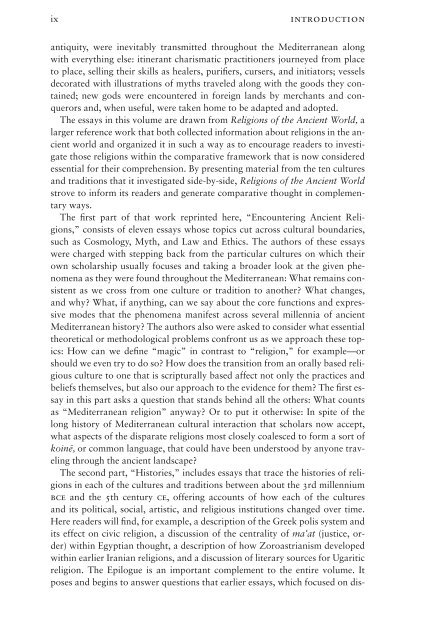You also want an ePaper? Increase the reach of your titles
YUMPU automatically turns print PDFs into web optimized ePapers that Google loves.
ix introduction<br />
antiquity, were inevitably transmitted throughout the Mediterranean along<br />
with everything else: itinerant charismatic practitioners journeyed from place<br />
to place, selling their skills as healers, purifiers, cursers, and initiators; vessels<br />
decorated with illustrations of myths traveled along with the goods they contained;<br />
new gods were encountered in foreign lands by merchants and conquerors<br />
and, when useful, were taken home to be adapted and adopted.<br />
The essays in this volume are drawn from Religions of the <strong>Ancient</strong> World, a<br />
larger reference work that both collected information about <strong>religions</strong> in the ancient<br />
world and organized it in such a way as to encourage readers to investigate<br />
those <strong>religions</strong> within the comparative framework that is now considered<br />
essential for their comprehension. By presenting material from the ten cultures<br />
and traditions that it investigated side-by-side, Religions of the <strong>Ancient</strong> World<br />
strove to inform its readers and generate comparative thought in complementary<br />
ways.<br />
The first part of that work reprinted here, “Encountering <strong>Ancient</strong> Religions,”<br />
consists of eleven essays whose topics cut across cultural boundaries,<br />
such as Cosmology, Myth, and Law and Ethics. The authors of these essays<br />
were charged with stepping back from the particular cultures on which their<br />
own scholarship usually focuses and taking a broader look at the given phenomena<br />
as they were found throughout the Mediterranean: What remains consistent<br />
as we cross from one culture or tradition to another? What changes,<br />
and why? What, if anything, can we say about the core functions and expressive<br />
modes that the phenomena manifest across several millennia of ancient<br />
Mediterranean history? The authors also were asked to consider what essential<br />
theoretical or methodological problems confront us as we approach these topics:<br />
How can we define “magic” in contrast to “religion,” for example—or<br />
should we even try to do so? How does the transition from an orally based religious<br />
culture to one that is scripturally based affect not only the practices and<br />
beliefs themselves, but also our approach to the evidence for them? The first essay<br />
in this part asks a question that stands behind all the others: What counts<br />
as “Mediterranean religion” anyway? Or to put it otherwise: In spite of the<br />
long history of Mediterranean cultural interaction that scholars now accept,<br />
what aspects of the disparate <strong>religions</strong> most closely coalesced to form a sort of<br />
koinÁ, or common language, that could have been understood by anyone traveling<br />
through the ancient landscape?<br />
The second part, “Histories,” includes essays that trace the histories of <strong>religions</strong><br />
in each of the cultures and traditions between about the 3rd millennium<br />
bce and the 5th century ce, offering accounts of how each of the cultures<br />
and its political, social, artistic, and religious institutions changed over time.<br />
Here readers will find, for example, a description of the Greek polis system and<br />
its effect on civic religion, a discussion of the centrality of maÚat (justice, order)<br />
within Egyptian thought, a description of how Zoroastrianism developed<br />
within earlier Iranian <strong>religions</strong>, and a discussion of literary sources for Ugaritic<br />
religion. The Epilogue is an important complement to the entire volume. It<br />
poses and begins to answer questions that earlier essays, which focused on dis








